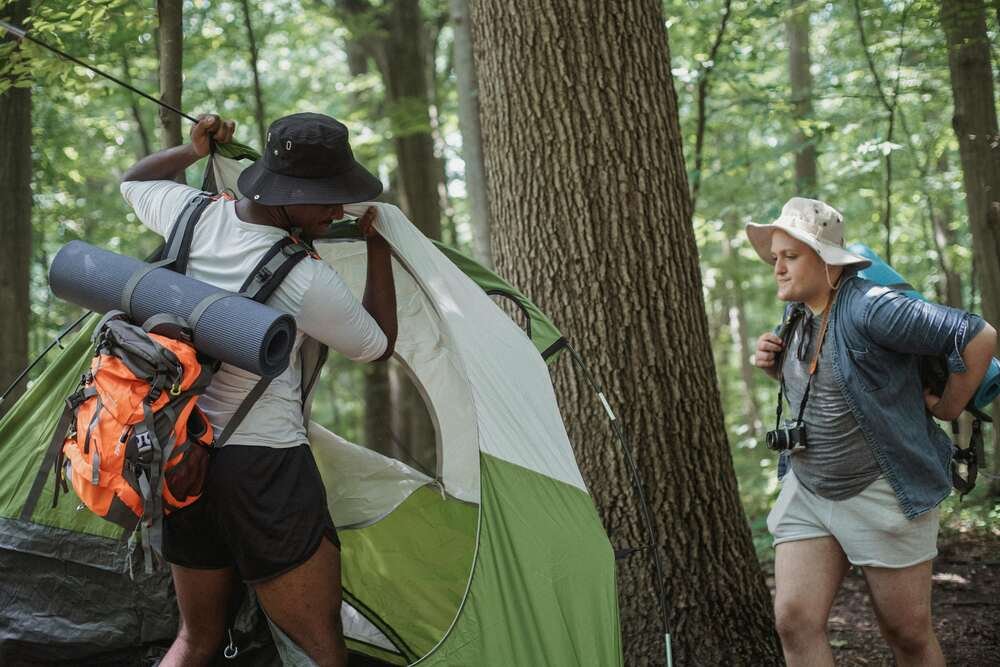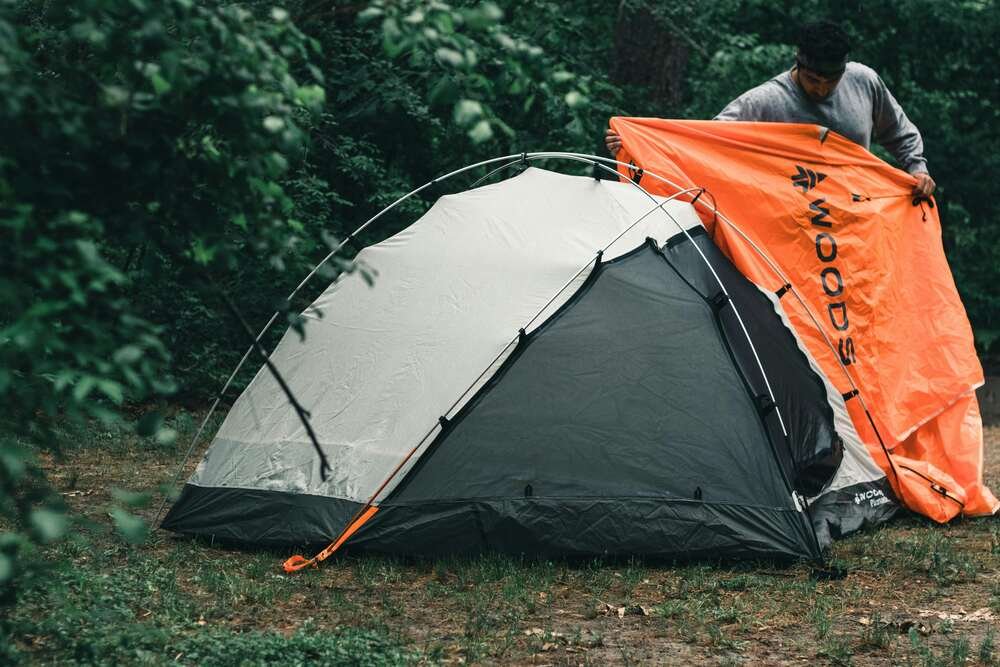How to Set Up a Campsite: The Ultimate Guide for Beginners
Your first camping trip can feel overwhelming, with so much to plan and pack! But with a bit of knowledge, you’ll transform this into a fun and relaxing adventure. From picking the perfect spot to packing out without a trace, this guide will walk you through the whole process. The goal? A stress-free, amazing outdoor experience. You’ll be relaxing around the campfire before you know it!
Selecting the Perfect Campsite in the Great Outdoors
Choosing a Location: Safety comes first when picking a campsite. Look for high, level ground to avoid flooding. Stay away from old or damaged trees to prevent falling branches. Make note of water sources – they’re handy, but make sure your site isn’t in a flood-prone area. You don’t want to set up camp only to wake up in a pool of water.
Types of Campsites: Consider both your comfort level and how much camping experience you have. If you’re a beginner or with a family, established campgrounds offer the most conveniences. These campgrounds often provide running water, toilets, and sometimes even electrical hookups. Plus, they have picnic tables, fire rings, and bear-proof food storage to keep things safe and easy.
For the more adventurous, there’s primitive wilderness camping! These remote sites offer a deeper connection with nature but have no amenities. You’ll need to bring everything you need and strictly follow Leave No Trace principles to protect the area.
The key is to choose a location that’s not only safe and comfortable but also lets you enjoy the type of camping you want to do. Careful planning means a safe, fun, and eco-friendly trip.
Preparing and Organizing Gear
Camping Checklist: Make sure you have the right gear! Before you leave, create a detailed checklist of all your camping essentials. This includes everything from tents and sleeping bags to cooking gear and first-aid kits. Double-check that your gear works and that you know how to use it.
Packing Tips: Pack smart, putting frequently used items like flashlights, matches, and your first aid kit where you can reach them easily. Think about weight distribution in your backpack or car for a safer, smoother journey.
Step-by-Step Guide to Setting Up Your Tent
Setting up your tent right means having a comfortable and safe home away from home while camping. This is especially important in diverse climates like South Africa. Let’s break it down:
Unpacking and Organizing
- Clear the Space: Remove any sharp objects, rocks, or branches where you’ll pitch your tent. This protects the material and makes a comfy sleeping spot.
- Unpack the Tent: Carefully take out your tent and all its parts (poles, stakes, rainfly) and spread them out. Make sure you have everything and nothing’s damaged.
- Organize Your Gear: Group things together. Keep your poles, stakes, and rainfly separate for a faster setup.
Laying the Groundwork
- Position the Tent: Lay your tent out on the cleared spot. Think about which way you want the door to face, considering wind direction and where the sun will rise.
- Secure the Footprint: If you’re using one, place the ground cloth or footprint under the tent. Make sure it’s a bit smaller than the tent’s base to keep rainwater from pooling.
Assembling the Tent
- Assemble Poles: Fit the segments of your tent poles together – they usually have elastic cords running through for easy assembly.
- Insert Poles: Depending on your tent, you’ll either slide the poles through sleeves or clip the tent to the poles. This creates the tent’s structure.
- Raise the Tent: Lift the tent using the poles. You might need help with larger tents. Position the poles correctly to form the tent’s frame.
- Secure the Tent Body: Once the frame is up, hook or clip the tent’s corners to the poles. Make sure the fabric is taut and the tent has the proper shape.
Securing the Tent
- Anchor with Stakes: Drive stakes through the tent’s loops or grommets at a 45-degree angle away from the tent. Use a hammer or mallet. This angle will make your tent strong against wind.
- Attach Guy Lines: Guy lines are for extra stability! Secure and tighten them, staking them out around the tent. They should be taut but not so tight they pull the fabric.
Applying the Rainfly
- Position the Rainfly: Place it over the tent, lining it up with doors and windows.
- Secure Corners: Fasten the rainfly’s corners to either the ground or the tent itself – it depends on the design. Some rainflies clip directly to the tent poles or stakes.
- Adjust for Ventilation: Tighten the rainfly so it’s secure but leaves enough room for air to flow and prevent condensation inside the tent.
With these steps, you’ll have a sturdy, weather-resistant tent that offers a great camping experience!
Pro tip: practice at home, pitch a tent in your yard or garden.
Arranging the Campsite
Planning the Layout: Think about where you’ll sleep, eat, and store food. In primitive sites, use natural features for shelter and seating. In established campsites, work with what’s provided and adapt to the space.
Setting Boundaries: Consider privacy and convenience as you arrange your space, especially in busier campgrounds.
Food Preparation and Storage
Meal Planning: Plan meals in advance for easy prep and minimal cleanup. Use coolers to keep perishables fresh. Store all food securely to keep animals out. Especially in bear country!
Cooking at Camp: Know your campsite’s rules about fires and always have a way to put one out quickly. Portable camp stoves are a great option, especially if open fires are restricted. If you do use a fire pit know what your are doing! Always practice fire safety.
Ensuring Comfort and Safety
Sleep Comfortably: Invest in good sleeping pads and choose sleeping bags with the right temperature ratings for a good night’s rest.
Secure the Site: Keep food and scented items in wildlife-proof containers to discourage unwanted visitors.
Environmental Consideration and Leave No Trace
Respecting Nature: Follow all local rules for protecting the environment. This includes disposing of waste properly, using established fire rings, and not disturbing plants and animals.
Clean-Up: Leave your campsite cleaner than you found it. Pack out all trash and food scraps and make sure there’s no sign you camped there.

Enjoying Your Camping Experience
Activities and Relaxation: Now that your campsite is set up, it’s time to explore the area, enjoy planned activities, or just relax and unwind from everyday life. Pack games, books, or crafting supplies to keep everyone entertained.
Connecting with Nature: Use this chance to teach kids and first-time campers about the importance of nature and outdoor ethics.
Tent Camping Essentials
For those opting for tent camping, here are ten essentials to ensure comfort and efficiency:
- Quality Tent: Choose one that’s right for the weather and has enough space
- Sleeping Bag: Choose one suitable for the season to keep you warm.
- Sleeping Pad: This provides insulation and comfort on the ground.
- Portable Stove: Lets you cook easily even without building a fire.
- Water Containers: Bring enough for drinking and cooking.
- Headlamp and Lanterns: These are essential for lighting your campsite.
- First-Aid Kit: Be prepared for minor emergencies.
- Multi-Tool: Handy for fixes and campsite tasks.
- Eco-Friendly Soap: Clean dishes and yourself without harming the environment.
- Weather-Appropriate Clothing: Be ready for everything with layers.
Backpacking Essentials
For the adventurers going further into the wild, pack light and don’t forget these ten essentials:
- Lightweight Backpacking Tent: Compact and easy to carry.
- Down or Synthetic Sleeping Bag: Compresses down for space-saving.
- Collapsible Trekking Poles: Offer support and stability on uneven terrain.
- Water Purification System: Essential for finding safe drinking water.
- Compact Cooking System: A small stove system that packs down easily.
- Nutrient-Dense Snacks: Give you sustained energy on longer treks.
- Navigation Tools: A GPS device or maps and a compass.
- Emergency Shelter: A lightweight bivy or emergency space blanket.
- Lightweight Layered Clothing: Adapt to changing weather quickly.
- Emergency Beacon or Satellite Messenger: For safety in remote areas.
Conclusion
Camping can offer amazing experiences and lifelong memories. Prepare well and follow these guidelines for a safe, comfortable, and fun time outdoors. Remember, every camping trip teaches you something new, building your skills and love for nature!

